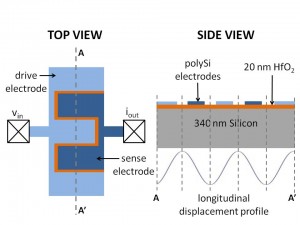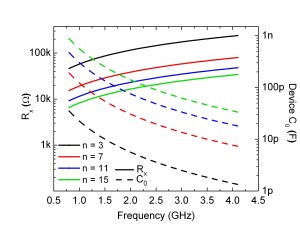RF MEMS Resonators for Body-area Network Transceivers

Figure 1: Schematic of longitudinal bar resonator with lateral dielectric transducer, showing an interdigitated electrode design.
Traditionally, RF circuits for wireless communications have used large-sized and low-quality-factor (Q) electrical RF components such as oscillators and filter banks, which create a bottleneck to miniaturization. Silicon-based micromechanical resonators can complement or even replace their electrical counterparts in existing wireless technology by providing RF building blocks with small size, low power, high-Q and multi-GHz frequency (high speed) functionality.
In this project, we are developing bulk acoustic resonators for use in low-power transceivers in Body-area Networks (BAN), as part of the Healthy Radios project sponsored by MARCO IFC/MSD. These networks will transmit data from multiple sensors for parallel monitoring of medical or environmental variables. An integrated solution for transceiver design employing multiple channels separated by 1 MHz in the 2.36 to 2.4 GHz Medical BAN band requires a bank of RF resonators with quality factors greater than those achievable using conventional LC tanks. We explore high-Q micromechanical resonators using lateral dielectric transduction [1] [2] at multi-GHz frequencies to achieve channel-select filtering and narrow-bandwidth frequency sources in the BAN transceivers. These devices are compared to piezoelectrically transduced devices, successfully demonstrated in the multi-GHz domain [3].

Figure 2: Frequency scaling of motional impedance Rx and nominal device capacitance C0 for the nth harmonic of longitudinal resonance in a dielectrically transduced Si bar.
The coupling coefficients of piezoelectric transducers are in general greater than those of their electrostatic counterparts. However, piezoelectric devices have limited quality factor due to mechanical losses in the piezoelectric material. Unlike piezoelectrics, dielectric transducers provide high Q and compatibility with CMOS for monolithic transceiver design. To this end, we scale Si-based lateral dielectrically transduced resonators to the BAN band at 2.4 GHz (Figure 1). The nth harmonic of longitudinal vibration in the bar is driven and sensed on alternate fingers of an interdigitated electrode design. Figure 2 provides the analytical frequency-dependence of motional impedance (Rx) and nominal capacitance (C0) for various harmonics with 20 nm of HfO2 transduction film on a 340-nm Si device layer. A motional impedance of ~10 kΩ is obtained for a 48-um device operating at the 15th harmonic but it is necessary to optimize for the nominal capacitance for these specifications. Optimization of Rx and C0 allows for integration of the resonators into the transceiver circuitry by making a feedback loop possible for an oscillator and providing low insertion loss for a bandpass filter.
References
- S. A. Bhave and R. T. Howe, “Silicon nitride-on-silicon bar resonator using internal electrostatic transduction,” International Conference on Solid-State Sensors, Actuators and Microsystems (Transducers 2005), pp. 2139-2142. [↩]
- D. Weinstein, H. Chandrahalim, L. F. Cheow and S. A. Bhave, “Dielectrically transduced single-ended to differential MEMS filter, “ IEEE International Solid-State Circuits Conference (ISSCC 2006), pp. 318-319. [↩]
- M. Rinaldi, C. Zuniga, G. Piazza “5 – 10 GHz AlN contour-mode nanoelectromechanical resonators,” IEEE Micro Electro Mechanical Systems (MEMS 2009), pp. 916-919. [↩]